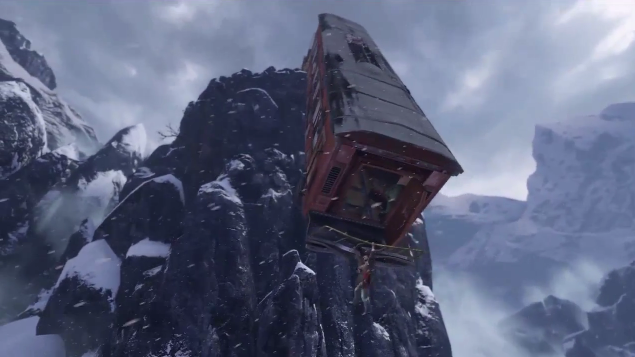
Featured Blog | This community-written post highlights the best of what the game industry has to offer. Read more like it on the Game Developer Blogs.
Traversal Level Design Principles
Traversal level design can be a tricky layout style to wrap your head around. These are the layout and gameplay principals I have learned to make a fun traversal level.

In 2010 I started at Crystal Dynamics to work on the 2013 Tomb Raider reboot. Within my first two weeks, I was entered into a “Thunderdome” exercise in which I had two days to revamp a traversal level, competing against a senior level designer who had worked on Assassin’s Creed 2. A winner would be chosen after the time expired and that level used in the game.
Prior, I had never designed a level for a game using more than a simple jump mechanic where the player could only land on their feet. You can probably guess that I lost, but what started was my education into the intricacies of laying out levels that use complex player traversal mechanics.
For the purposes of this article I define Traversal Gameplay as any gameplay where the player is actively moving around a space. Stepping up / down, hurdling, mantling, climbing and swinging are all examples of traversal gameplay (but there are lots more!). Before we dive into talking about principles, we need to identify the types of traversal level design which these principles apply to. Then I will dive into the meat and potatoes of this article.

Types of Traversal Level Design
Linear – Setups where there is only one main path. These can be action moments, story moments or just a simple down beat in the level intensity ramp. Think Nathan Drake climbing up a cargo net hanging behind a plane in Uncharted 3 or climbing up a radio tower in Far Cry 3 or 4.


Open – Setups that have multiple branching paths. Open setups allow the player to choose one of many branching routes to get to the objective. Examples include hubs in Tomb Raider or any of the big cities in the Assassin’s Creed Series.


Enemy Encounter Traversal – Either an open or linear traversal path that has enemies in it. When enemies are present, you need to adhere to a few extra rules to make sure their behaviors play out correctly and the space allows for smooth fluid engagements. Think of bounty hunts or assassinations in the Assassin’s Creed Series or any of the Tomb Raider and Uncharted levels that use lots of verticality and combat.


General Principles
Principles that can apply to any of the three above types. My focus is on third person and first person games, some of these may not apply to side scrolling games.
1. Utilize 3D Space
When I lost in the Thunderdome exercise, my big mistake was only making a path the player could climb up, down, left and right. Great traversal setups let the player move around a space, inside the space, on top of the space and even under it.
Think of a cabin in the woods. For it to be “great” to traverse around, you need to be able to climb the outside walls, into the cabin, out of the cabin, onto the cabin roof and even under the cabin through the crawlspace.
Utilizing all the space makes the setup feel more natural, encourages choice and promotes replayability. Even if a path is linear utilizing the 3D space will freshen up the gameplay path and make it feel more exciting.
2. Variety is the Spice of Life
Most games with traversal these days have a lot of traversal mechanics: ledge climbing, hand hold climbing, drain pipe climbing, pole swings, etc, etc. The last thing you want to do is use the same move over and over again when there is such a large bucket of moves to choose from. A general rule is to never use the same traversal mechanics more than two or three times in a row. Please note, this is a general rule. Certain mechanics like monkey bars are fine to use more than that because the move is so quick. When in doubt, feel it out through play testing.
Another general rule is to not go in the same direction for too long. Another way to think of it: “Is the player pressing the same inputs over and over again in my level?” An example of this is a ledge the player is shimmying along. A designer could0 layout a long straight ledge that takes thirty seconds to scoot down, like in the below drawing.
That can be very dull. Spice it up by breaking the ledge and making the player go up or down to continue. For example, in the drawing below, we can break the ledge and insert climbing between ledges and handholds as well up and down movement. By taking one action and breaking it into six different actions, you get a more varied and fun feeling to the path.
Open setups can have long straight paths because they are architecturally necessary. For example, Assassin’s Creed has them all over the place, but it works because the player can break out of them at almost any time. This can be seen in the image below, where the player is not locked into a long straight path while shimmying along the roof.

3. No Vague Traversal Geometry
If the player can climb on it or perform any other traversal move, it needs to be crystal clear that it is a traversal path. If it looks like you can traverse something, players will try. If they think they can traverse and cannot, then they will get frustrated. This usually becomes a problem when a level goes from being block mesh to being arted. Keep an eye out for it yourself and in play testing.
Take a look at how other games deal with this. Last of us uses the color yellow and in their traversal primitives to draw the player along.

Uncharted places special blocks for handhold climbing that are different than the wall they are placed upon so they stand out. Look at how the red handholds pop against the blueish grey wall.
Most of the climbable ledges in Tomb Raider have an element of white in them for the same reasons.

4. Forbidden is Desirable
The coolest places to traverse are the places we fear to be in real life. That’s one reason why climbing on tall buildings is fun in the many games that have that type of experience now. When you need to spice up your level, add a dangerous feeling place for the player to go. You don’t have to add extra gameplay for it to be special, just the feeling of being in that place will be meaningful and fun for the player.
For example, in Batman Arkham Knight there is a level where the player must glide on top of a zeppelin. I spent ten minutes just walking around on top of the zeppelin, looking around and soaking in how cool it was to be a dangerous place with an awesome view. For me, it was one of the coolest moments in a game filled with awesome traversal moments and all I did was one glide move and then walk around.
Another similar example is the Synchronization Viewpoints in the Assassin’s Creed series. You do the same traversal moves as you do elsewhere in the city, but it feels great because you travel up so high.
Naughty Dog is the king of these with examples like the train hanging over a cliff, hanging behind an air plane, climbing along moving trucks and trains. All of these are spectacular because they put you in a place you fear in real life.

5. When in doubt, Move it About
Adding movement is a great way to make an aspect of your traversal more exciting. Something static in the environment can become fun moments with just a little bit of movement. Uncharted 3 had a cool example with two chandeliers the player swings back and forth on in the Chateau level.
Assassin’s Creed Syndicate added a super fun element when they allowed the player to climb on moving horse-drawn carriages. The movement took what could have a been a simple set piece and turned it into an exciting adventure.

6. 180 Degree Turns are bad.
When the player gets to the next step in a traversal path, try really hard not to have them turn 180 degrees around to continue along the path. It is not intuitive for the player’s next path to be directly behind them, a lot of players look 180 degrees in front of them for the next path. Also, the 180 degree turn usualluy must be done in a small space in these cases, when a larger space is needed for the turn to feel fluid and smooth. For example in the drawing below, if the player jumps up to a ledge, pulling himself up, do not make him turn all the way around to make the next jump.
7. Leave Room for the Camera
The camera lets the player see all the cool traversal moves the player is doing. Problems with the camera mostly occur in third person games because the camera is on a track behind the player. Because the camera follows behind the player, it can knock into geometry in the environment. When that happens the camera can jerk or pop. Notice in the image below from Shadows of Mordor how there is lots of room for the camera to move around the player as they travel along the ropes, allowing for smooth camera movement.

Special Enemy Encounter Principals
These are specific to when there are enemies in the traversal level.
1. Quick Paths are Good
When the player gets attacked by enemies, they need fast traversal escape routes to allow them to get to get out of harm’s way. A fast route would be a traversal path that the player may maneuver through quickly. If all you have are long traversal routes that leave the player exposed, then players will get frustrated because you are leaving them open to attack for too long.
Not all your paths need to be quick, but enough so that when the player assesses (makes their combat plan), they can easily find a quick way out. The Shanty Town level in Tomb Raider 9 is a good example of lots of quick traversal routes to get the player out of danger.

2. Allow Enemy Attacks Everywhere
Sometimes when a level is created or enemies added to an existing level, the layout may have places where the player cannot get attacked. This is bad not only because it makes the enemy AI look unintelligent, but also because it can break the 4th wall for the player. Also, the player does not have to move, breaking the basic combat loop of assess -> move -> attack. That breaks the intensity of the encounter.
A flushing behavior can be anything that harms the player and forces the player to move. The easiest solution in most cases is to modify the layout just enough so the enemy can throw a grenade or perform a flushing behavior to get the player out of the safe spot and back into battle. In Tomb Raider 9 I inherited a level with raised platforms certain enemies could not climb up and I didn’t have art cycles to change it. If that certain enemy type was the last type alive, things could get wonky because the enemy did not have a behavior to force the player off the platform.
Rules are Meant to Be Broken
Please keep in mind that these are all general rules and that special case situations or mechanics can change that. For example, The glide and grapple combination in the Batman series is one of the most fun traversal combinations ever made and feels great to repeat often.
The same can be said of web swinging in Spider Man.
These principles may apply to most of your game’s traversal mechanics, but always feel through your layout and watch play testers to decide when something is a special case scenario. Thanks for reading!
Read more about:
Featured BlogsAbout the Author(s)
You May Also Like












